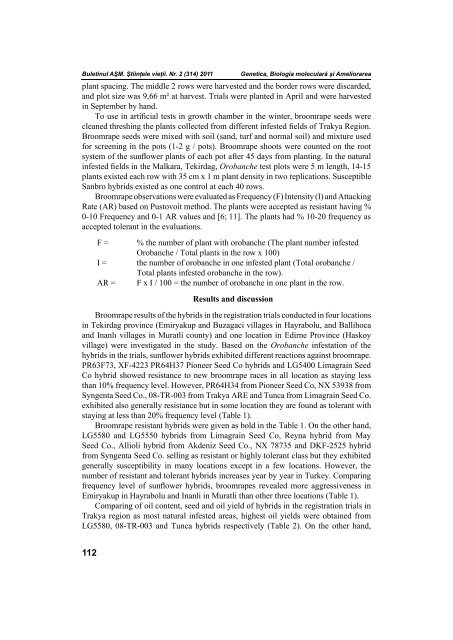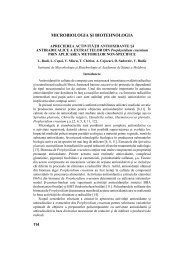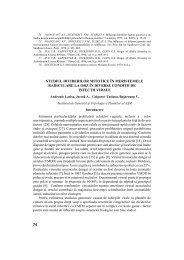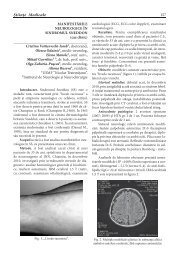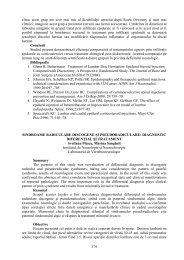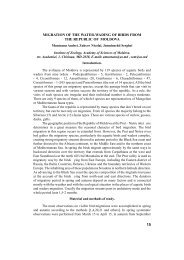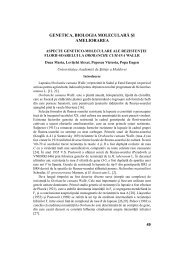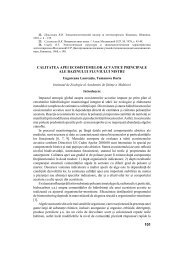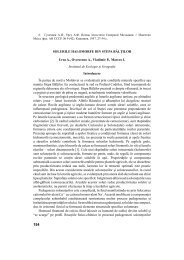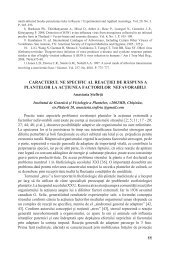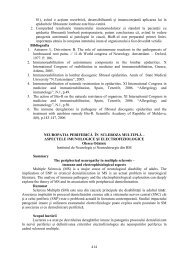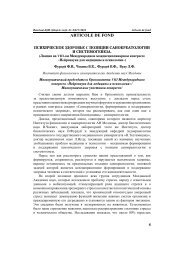209 CONTENTS
209 CONTENTS
209 CONTENTS
You also want an ePaper? Increase the reach of your titles
YUMPU automatically turns print PDFs into web optimized ePapers that Google loves.
Buletinul AŞM. Ştiinţele vieţii. Nr. 2 (314) 2011<br />
plant spacing. The middle 2 rows were harvested and the border rows were discarded,<br />
and plot size was 9,66 m² at harvest. Trials were planted in April and were harvested<br />
in September by hand.<br />
To use in arti cial tests in growth chamber in the winter, broomrape seeds were<br />
cleaned threshing the plants collected from different infested elds of Trakya Region.<br />
Broomrape seeds were mixed with soil (sand, turf and normal soil) and mixture used<br />
for screening in the pots (1-2 g / pots). Broomrape shoots were counted on the root<br />
system of the sun ower plants of each pot after 45 days from planting. In the natural<br />
infested elds in the Malkara, Tekirdag, Orobanche test plots were 5 m length, 14-15<br />
plants existed each row with 35 cm x 1 m plant density in two replications. Susceptible<br />
Sanbro hybrids existed as one control at each 40 rows.<br />
Broomrape observations were evaluated as Frequency (F) Intensity (I) and Attacking<br />
Rate (AR) based on Pustovoit method. The plants were accepted as resistant having %<br />
0-10 Frequency and 0-1 AR values and [6; 11]. The plants had % 10-20 frequency as<br />
accepted tolerant in the evaluations.<br />
112<br />
F = % the number of plant with orobanche (The plant number infested<br />
Orobanche / Total plants in the row x 100)<br />
I = the number of orobanche in one infested plant (Total orobanche /<br />
Total plants infested orobanche in the row).<br />
AR = F x I / 100 = the number of orobanche in one plant in the row.<br />
Results and discussion<br />
Genetica, Biologia moleculară şi Ameliorarea<br />
Broomrape results of the hybrids in the registration trials conducted in four locations<br />
in Tekirdag province (Emiryakup and Buzagaci villages in Hayrabolu, and Ballihoca<br />
and Inanlı villages in Muratli county) and one location in Edirne Province (Haskoy<br />
village) were investigated in the study. Based on the Orobanche infestation of the<br />
hybrids in the trials, sun ower hybrids exhibited different reactions against broomrape.<br />
PR63F73, XF-4223 PR64H37 Pioneer Seed Co hybrids and LG5400 Limagrain Seed<br />
Co hybrid showed resistance to new broomrape races in all location as staying less<br />
than 10% frequency level. However, PR64H34 from Pioneer Seed Co, NX 53938 from<br />
Syngenta Seed Co., 08-TR-003 from Trakya ARE and Tunca from Limagrain Seed Co.<br />
exhibited also generally resistance but in some location they are found as tolerant with<br />
staying at less than 20% frequency level (Table 1).<br />
Broomrape resistant hybrids were given as bold in the Table 1. On the other hand,<br />
LG5580 and LG5550 hybrids from Limagrain Seed Co, Reyna hybrid from May<br />
Seed Co., Allioli hybrid from Akdeniz Seed Co., NX 78735 and DKF-2525 hybrid<br />
from Syngenta Seed Co. selling as resistant or highly tolerant class but they exhibited<br />
generally susceptibility in many locations except in a few locations. However, the<br />
number of resistant and tolerant hybrids increases year by year in Turkey. Comparing<br />
frequency level of sun ower hybrids, broomrapes revealed more aggressiveness in<br />
Emiryakup in Hayrabolu and Inanli in Muratli than other three locations (Table 1).<br />
Comparing of oil content, seed and oil yield of hybrids in the registration trials in<br />
Trakya region as most natural infested areas, highest oil yields were obtained from<br />
LG5580, 08-TR-003 and Tunca hybrids respectively (Table 2). On the other hand,


